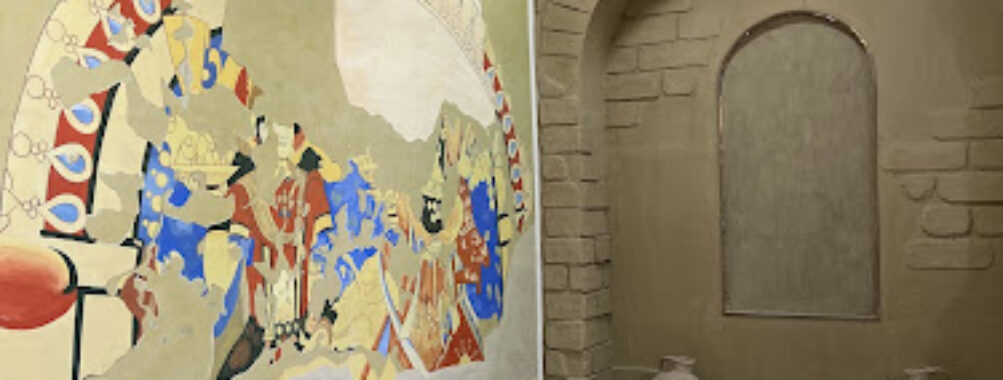
Afrasiyab Museum
“`html
Table of Contents
Description
The Afrasiyab Museum in Samarkand is one of those places that quietly pulls you in with its history rather than flashy displays. It’s an archaeological museum built right on the site of ancient Afrasiyab, the old heart of Samarkand before the city shifted south. When you step inside, you’re not just looking at artifacts behind glass—you’re peering into fragments of a city that thrived more than a thousand years ago. The museum is best known for its 7th–8th century palace frescoes, which are rare survivors of early Central Asian art. The colors are faded, sure, but the storytelling in those paintings—depicting ambassadors, royal ceremonies, and everyday life—still sparks the imagination. I remember standing in front of one fresco, squinting at the details, and suddenly realizing I was looking at a scene that once decorated the walls of a ruler’s palace. That’s the kind of moment that sticks with you.
Not everything here is jaw-dropping. Some visitors might find the collection of coins, tools, and ceramics a bit modest compared to bigger museums. But that’s also part of its charm. It feels authentic, almost like a time capsule. You get to see the small, ordinary objects that people used centuries ago, and somehow that makes the past feel closer. The museum itself is not huge, so you won’t be wandering for hours, but what it lacks in size, it makes up for with atmosphere and context. If you’re the kind of traveler who enjoys piecing together history like a puzzle, you’ll probably appreciate it more than someone just looking for grand displays.
The facilities are practical and straightforward: wheelchair access is available, restrooms are on-site, and there’s free parking outside. It’s also fine for kids, though younger ones might get restless unless you make a game out of spotting different artifacts. There isn’t a café or restaurant inside, so it’s smart to plan your meals elsewhere. Overall, the Afrasiyab Museum isn’t trying to be a blockbuster attraction. It’s quiet, it’s thoughtful, and it rewards the curious traveler who’s willing to slow down and listen to the whispers of history.
Key Features
- 7th–8th century palace frescoes, unique in Central Asia
- Excavated artifacts including coins, ceramics, and everyday tools
- Exhibits that highlight the history of ancient Samarkand (Afrasiyab)
- Wheelchair accessible entrance, restroom, and parking
- Free parking lot available on-site
- Family-friendly environment, suitable for children
Best Time to Visit
If you’re planning a trip, spring and autumn are the sweet spots. The weather in Samarkand during April–May and September–October is mild and pleasant, making it easier to explore not just the museum but also the surrounding archaeological site. In the summer, the heat can be relentless, and while the museum itself is indoors, you’ll likely want to walk around the ruins outside, which can be exhausting under the midday sun. Winter is quieter, and if you don’t mind chilly air, you’ll practically have the place to yourself—though the city as a whole feels more subdued then. Personally, I loved visiting in the fall, when the light is golden and the air just crisp enough to make you want to linger.
How to Get There
The museum sits a little outside the main touristy core of Samarkand, but it’s still easy to reach. Most travelers take a short taxi ride from Registan Square, which usually takes less than 15 minutes. If you’re more adventurous, you could hop on a local bus, but taxis are affordable and save time. Drivers in Samarkand are familiar with the Afrasiyab Museum, so you won’t have to worry about explaining directions. I once tried walking there from the city center—it took me about 40 minutes, and while it was doable, the sidewalks weren’t always great. If you’re short on time, I’d recommend saving your energy for exploring the site itself.
Tips for Visiting
First off, don’t rush. The museum isn’t massive, but the details are what make it special. Spend time studying the frescoes—you’ll notice new things the longer you look. If you enjoy context, consider hiring a local guide. They often share stories and interpretations that aren’t written on the display boards, and that extra layer of narrative really brings the artifacts to life.
Bring water, especially in summer, since there’s no café or vending inside. And if you’re traveling with kids, turn it into a treasure hunt—ask them to find coins, animals, or patterns in the frescoes. It keeps them engaged and makes the visit more fun. Photography is allowed in some areas, but always check the signs before snapping away.
One more thing: go with the right expectations. This isn’t a glitzy, high-tech museum. It’s quieter, more academic, and rooted in archaeology. If you approach it with curiosity, you’ll leave with a deeper appreciation of Samarkand’s ancient roots. And honestly, that’s what makes it worth the stop.
“`
Location
Places to Stay Near Afrasiyab Museum
Find and Book a Tour
Explore More Travel Guides
No reviews found! Be the first to review!